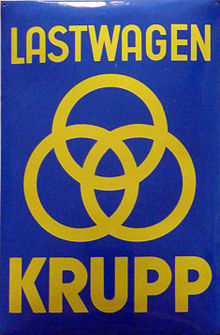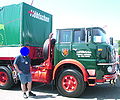Fried. Krupp engine and vehicle factories
Fried. Krupp Motoren- und Kraftwagenfabriken ( Krupp Krawa for short ) was a subsidiary of the German heavy industry company Krupp (today part of ThyssenKrupp ) and manufactured commercial vehicles , trucks , dump trucks and buses that bore the Krupp brand name. The production of commercial vehicles began after the First World War in 1919 and ended in 1963 (omnibuses), 1968 (trucks) and 1969 (dump trucks). Between 1946 and 1954 the brand name “Südwerke” was used instead of “Krupp”.
Trucks
Krupp trucks were widely used after World War II . After the company was an important armaments supplier ( Alfried Krupp von Bohlen und Halbach was convicted as a war criminal after the war), production could not be resumed until 1946. Instead of being manufactured at the headquarters in Essen , the trucks were manufactured in Kulmbach , Bamberg and Nuremberg until 1951 and were not sold with the incriminated name Krupp, but under the name "Südwerke" until 1954.
The first post-war constructions
In 1950 Krupp launched the Titan heavy-duty truck . This long-hooded truck has a two-stroke diesel engine developed by Krupp with 190 hp (from 1951 with 210 hp) and was thus the most powerful German truck. The planned engine size as a six-cylinder was not permitted according to the guidelines of the Allied occupying powers . Instead, Krupp installed two individually operable three-cylinder engines one behind the other, which were connected with a gear drive. Because of the characteristic noise this engine makes when idling (" Kropp-kropp-kropp "), truck drivers used to say that the Krupp Titan was the only truck that could say its name.
In 1951, the slightly smaller Mustang and the light buffalo supplemented the "truck menagerie " from Krupp.
In the Krupp truck factory, unconventional paths were often taken: When the cardan shaft of a new, small truck model frequently broke at the beginning of the 1950s , investigations and calculations revealed that it made sense to use the cardan shafts (instead of thicker and stronger) to build a little weaker and thinner-walled. This changed the vibration behavior of the component in such a way that the critical range of the natural frequency , which had previously caused vibration breaks, was no longer passed. The newly designed, thinner cardan shafts withstood the stresses and strains of everyday use.
Modernizations and revisions
Krupp Widder of the THW
In 1955, Krupp's truck range was modernized. The hoods of the vehicles were now flatter and more angular. The successor to the Titan was named Tiger and was also equipped with a two-stroke diesel engine. The unit in the Tiger made 185 hp. The Mustang and the Buffalo were also revised, but kept their names. A new five-tonne type ram was added. In 1956, the elk model replaced the ram. Up until 1959, changes and improvements were made to the various models, e.g. B. built in full instead of split windshields. The first forward control vehicles with a fixed cab also came onto the market.
New front handlebars and hoods
In 1959 Krupp brought a new generation of trucks onto the market, the cabs of which were very modern. As part of this, the type designations were converted to three-digit number codes (e.g. type 501). The new models were offered as hooded vehicles as well as forward control vehicles.
In 1965, Krupp was the first German truck manufacturer to equip its front control vehicles with tilting driver's cabs as standard. A prototype with a tilting cabin from Magirus-Deutz had previously been available, but this never went into series production. The tiltability of the cab improved the accessibility of the engine for maintenance and repair work considerably compared to the fixed cab and is standard today.
The end of truck production
After the two-stroke diesel engines from Krupp got worse and worse on the market, the decision was made to build four-stroke diesel engines from Cummins under license from 1963 . But even this measure could not prevent the Krupp trucks from selling well enough. In the end, Krupp's market share of heavy trucks had fallen to just two percent, and the manufacturer had not been represented for lighter vehicles for a long time. When the management began to sift through the structures of the Krupp Group in the mid-1960s, the end came for the traditional Krupp Krawa: in 1968, just one year before the 50th anniversary of Krupp truck construction, the trucks were introduced -Production started without replacement, the sales organization was taken over by Daimler-Benz . The German commercial vehicle industry thus lost an interesting supplier, which was soon to be followed by more with the equally established brands Büssing and Henschel . Successor models for the heavy forward control vehicles had already been developed, but were no longer on the market due to the meanwhile strong deficit of the Krupp truck division and because an improvement in sales figures was not to be expected.
All important wear and spare parts were available until the mid-1980s. Together with Cummins, Krupp had taken precautions and maintained a well-stocked spare parts warehouse at the former factory location on Helenenstrasse in Essen , which Krupp truck customers could still supply with the parts they needed many years after the production stop.
The last Krupp trucks disappeared from the everyday street scene in the early to mid-1980s. With collectors and classic car fans, the vehicles from Essen with the three rings on the front are popular again and can be seen more often at relevant vehicle meetings.
Dump truck
The production of dump trucks was closely linked to truck production, and their construction was usually derived from truck models. After truck production was discontinued at the end of 1968, the dump trucks (some with two-stroke engines as well) were manufactured and sold until 1969; after this production branch was discontinued at Krupp, Faun took over the remaining copies that had not yet been sold.
Omnibuses and trolleybuses
For a time, Krupp also manufactured omnibuses, which were particularly common in West Germany. However, the annual production figures never exceeded double-digit numbers, the best year of production was 1955 with 64 units built. In 1960 and 1961, only three vehicles were built together. Therefore, the production was given up in 1963, before the truck was built. In addition, Krupp manufactured the chassis for 80 trolleybuses of the Trolleybus Solingen type between 1968 and 1974 . They were based on standard truck chassis.
Further products
The "Friedrich Krupp AG, engine construction department" in Essen manufactured a " motorized runner" - that was the name for scooters at the time - with a 185 cm³ single-cylinder four-stroke engine , which was mounted above the left side of the front wheel. This single-seat small scooter was only 130 cm long. Presumably this is the first German-made scooter. In 1921 an improved model with a 198 cc engine came out. Both models were not economically successful; Production ended in 1922.
In the 1920s there was a three-wheel sweeper from Krupp. The construction was after the Second World War by Magirus-Deutz modified and under the name "Mokema" ( Mo gate Ke hr- Ma continued to build machine).
See also
literature
- Bernd Regenberg: The truck album KRUPP. Podszun, Brilon 1996, ISBN 3-86133-157-8 .





























